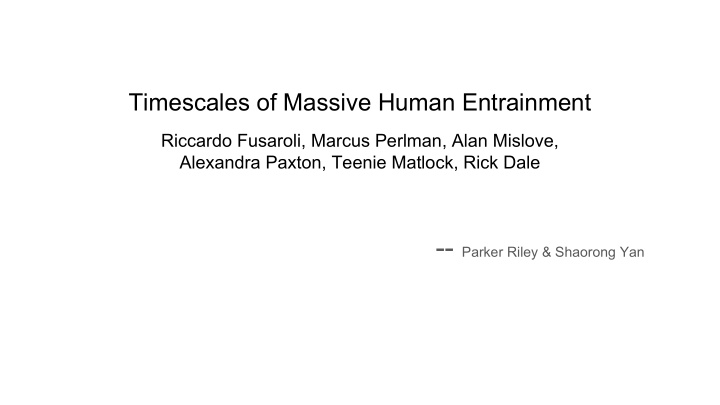



Timescales of Massive Human Entrainment Riccardo Fusaroli, Marcus Perlman, Alan Mislove, Alexandra Paxton, Teenie Matlock, Rick Dale -- Parker Riley & Shaorong Yan
Coordination in human interaction - Joint attention: - Important for communication (Clark, 1996) and language acquisition (Tomasello, 1986). - Achieved through gesture (pointing, nudging), eye gaze, or verbal cues.
Richardson & Dale, 2005
Richardson & Dale, 2005 Recurrence peak at 200ms
Richardson, Dale, & Kirkham, 2007 Recurrence peak at 0ms
Coordination in human interaction - Joint attention: - Important for communication (Clark, 1996) and language acquisition (Tomasello, 1986). - Achieved through gesture (pointing, nudging), eye gaze, or verbal cues. - Multi-modal coordination
Louwerse et al., 2012
Coded behaviors
Significant cross-recurrence
Synchronization of nodding
Synchronization of cheek touching
Other patterns - Synchronization increases - As experiment proceeds - As the task becomes more difficult
Moving from lab to big data - Large-scale collective behavior using social media - Twitter: - Short in format - Widespread integration with mobile devices - Collective attention - Entrainment - Pros and Cons?
Event: 2012 US presidential debates - Participant: - Candidates: Barack Obama and Mitt Romney - Moderator - Audio recordings and transcripts - National Public Radio (www.npr.org).
Twitter data - Random sample of approximately 10% of all public tweets collected during each 90-minute presidential debate. - Filtered tweets to select only those that mentioned "Obama" or "Romney," either in the text or in their hashtag, - Excluded tweets containing URLs (to exclude spambot-generated tweets).
Hypotheses - Three different timescales: - Interactional entrainment - Content entrainment - Long-term attention decay
First Timescale: Interactional entrainment. - Assertive behaviors - Keeping the ground - Interrupting the adversary
Second Timescale: Content entrainment - Pointed or “salient” remarks that became memes - Requires more intensive cognitive processing - Responses start later - Stay longer
Third Timescale: Long-term attention decay - Attention is unlikely maintained all the way - General interest in the debate should decay after initial burst
Models - Overview - Independent variables - Current Speaker - Speaking Time - Interruption - Dependent variables - Tweet mentions of the candidate per second - No notion of positive/negative mentions
Models - First Timescale (Interaction) - Tested two linear mixed-effect models, for each debate - First Model - Speaker, duration of turn, and interaction between them as fixed effects - Turn number as random effect with nested slopes for candidate identity and time within turn - Second Model - Same, with interruptions as additional fixed factor
Models - Second Timescale (Content) Exponential decay (N(t) = e -ƛt ) coupled w/ sigmoid (M(t) = 1 / (1+e -m(t–s) )) - - Sigmoid captures hypothesis of self-sustaining factor (meme virality) - s : point (in seconds) when meme tweet rate is highest - m : slope of mention rate at time s - Used product: M(t)[N(t) - b], where b is mean base tweet rate in final 100s - Found parameters with simple search across reasonable values, maximizing correlation between data and model
Models - Third Timescale (Long-Term Attention) - Linear multiple regression model - Independent variable: second-order polynomial - Dependent variable: tweets per second - Also assessed fit of just the quadratic time term (capturing decay) in second half of debate
Models - Combined - Unified model to predict tweet number - Independent variables: speaker duration, interruption, salient moment, quadratic time - Dependent variables: tweets per second
Results - Interaction - Speaker co-variance - Mentions of a candidate increased when they were talking - Model explained at least 10% of variance in all three debates, and over 30% for the second - Effect of duration was negative, but outweighed by positive factor of current speaker - As each turn got longer, tweets slowed down, but focus remained on speaker
Results - Interaction - Interruptions - General increase in mentions of all participants when turn started with an interruption - Effect was much smaller than speaker identity, but significant in all three debates
Results - Content - Mentions of the salient moments (memes) spiked after about a minute, then decayed over the next few minutes
Results - Long Term Decay - Predicted with first- and second-order time terms, both of which account for >20% of variance in each debate - Linearly increasing term (.28) less than quadratic term (.34) - Latter half characterized by decay
Results - Combined - When including all above factors in the analysis, over 50% of variance in tweet rate was explained - Each variable uniquely contributed - Model for the first debate explained ~10% of variance in second and third
Future Work - Positive/Negative mentions - Political leanings of users - Effect on public opinion
Conclusion - Evidence of entrainment in humans, similar to effects documented in fireflies, starlings, fish, etc - Effects visible in hundreds of thousands of individuals within minutes or seconds - Social media enhances these effects (faster, stronger)
Discussion - What are the merits and drawbacks of performing this type of study compared to lab experiments? - What other phenomena can be started using “big data” from social media?
Thx for your time and questions!
Recommend
More recommend